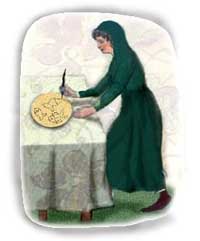|
In the days of the Talmud some matzot
were made with designs on them. This is revealed in a lengthy discussion by
rabbis of the time. Even though the use of matzot decorated with figures
was not encouraged for compliance with the law of eating unleavened bread, the
sages said that if one does eat them he acquits himself of his duty.
Boethus ben Zonin (perplexed): Why is
it not permitted to prepared figured cakes on Passover?
The rabbis: Because the woman, in preparing them, tarries over her
work (to illustrate the matzot, and does not put them quickly into
the oven) and in the meantime the dough becomes leavened.
Boethus ben Zonin (not satisfied with this reply): Perhaps she could
form the dough in a mold or plate, thus impressing the figures on the cake
quickly, without loss of time?
The rabbis (with great patience): In that event, it would be said that
all figured cakes are prohibited and only those made by Boethus are permitted.
 The
opposition of the rabbis was based on the ground that no discrimination can
be shown in favor of any particular stamping as most of the bakers did not
have a ready-made figured plate.
Rabbi Elazar bar Zadok related that one Passover
he went with his father to the house of Rabban Gamliel, and there he served
matzot with perforations that represented figures. When he called his
father's attention to the admonition of the sages not to make figured cakes
of Passover, Zadok replied: "This prohibition does not apply to every householder
who bakes for himself, as one would not expect that he will beautify them to
such an extent that he will delay and allow the dough to become leavened. This
was said about bakers who sell their products, and therefore they are careful
about their appearance and spend time on the design."
There were other rabbis who maintained that figured (illustrated) matzot
of bakers are not forbidden as they are expert and have the necessary molds.[1]
Maimonides agreed with the latter and permitted bakers to make unleavened bread
with illustrations, but prohibited householders from doing so even if they had
a mold, lest others do so without a mold.[2]
The figures used to ornament the matzot were likenesses of doves, fishes
and other forms, according to Rabbi Isaac ibn Gayyat.[3]
Other artistic perforations were evidently also in usage, such as animals and
flowers, but all of these were later prohibited except such designs as could
be made with a comb-like implement and with perforated holes.[4]
The use of a mold or plate was likewise forbidden, as the dough enters into
it and becomes like leaven.[5]
Later on, perforations were made with a sharp-toothed wheel, called a redel,
attached to a handle. The purpose of using the redel was to prevent the
dough from rising during the baking, rather than to beautify the matzot.
 In
some communities there was a custom of inscribing the three matzot used
at the seder with "Cohen," "Levi," and "Israel," the names by which each
was called, to be able to differentiate between them. Others marked each of
them with one of the first three letters of the Hebrew alphabet. In
some communities there was a custom of inscribing the three matzot used
at the seder with "Cohen," "Levi," and "Israel," the names by which each
was called, to be able to differentiate between them. Others marked each of
them with one of the first three letters of the Hebrew alphabet.
In a number of illustrated Haggadot there are pictures of matzot with
various designs. A haggadah manuscript in the Michaelis Collection at
Oxford has an illustration of a matzah with a design of chains, symbolizing
the Egyptian bondage.[6]
In the Middle Ages matzot were an inch thick, or about the thickness
of a finger.[7] Later on, they were
made much thinner.
Until the past century, matzot were usually round. This is undoubtedly
due to the biblical term uggot matzot (Exodus 12:39) which has a double
meaning: cakes of unleavened bread and circles of unleavened bread (uggah
is related both to the word for cake and to the root-word for round). Many are
still scrupulous to use the round matzot.[8]
With the advent of machine-made matzot, the shape became square.
 |
[1]
Babylonian Talmud Pesahim 37a, Rashi: The figured matzot are
called "seikin mezuyarin" which may indicate that the perforations
and designs were done with a comb-like implement, as "serikin" indicates.
[Back]
[2] Hilkhot Hametz u-Matzah 5.15 [Back]
[3] Maggid Mishnah on Hametz u-Matzah 5.15
[Back]
[4] Orah Hayyim 460.4 [Back]
[5] Eshel Abraham, Orah Hayyim 460.4 [Back]
[6] Abrahams, Israel, "The Shape of Matzot," The
Book of Delight and Other Papers, JPS, Philadelphia, 1912, pp. 290-300.
[Back]
[7] Bet Hillel, Yoreh Deah 96 [Back]
[8] Rashi, Moed Katan 4b [Back] |
 |
 From
the chapter "Passover in History," in The Passover Anthology, JPS,
1993. Printed with the permission of the publisher. From
the chapter "Passover in History," in The Passover Anthology, JPS,
1993. Printed with the permission of the publisher. |
 |
The illustration
of the figure perforating a matzah is inspired by a similar illustration
in the Rotschild Miscellany, Italy, 15th century. |
NISAN Table of Contents
|



